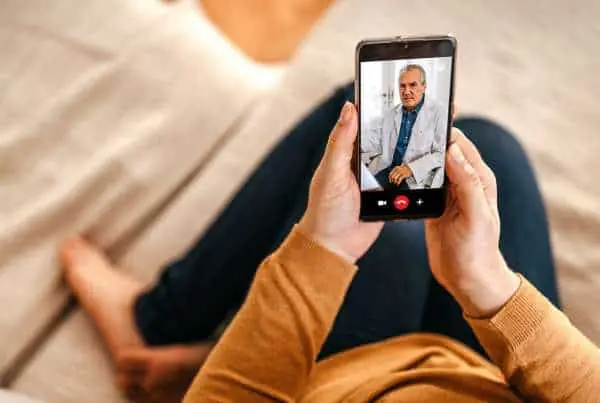The ability to receive health services from a distance has been around ever since the telephone has existed. Even though it was available, however, there were not a large number of practitioners or patients who preferred it over the traditional office visit.
Telehealth services had started to receive more support over the past decade, as our population grew and the technology for it became more sophisticated. Now that the presence of COVID-19 has altered our way of life, there is an intensified focus on the applicability of utilizing telehealth to meet our physical and mental health needs.
Telehealth refers to the ability to gain insight and relief from consulting with a professional, without leaving the comfort of your home. If you have ever completed a digital screen form for your therapist or doctor, you have already participated in a form of telehealth.
When it refers specifically to receiving counseling and mental health therapy services, it is often referred to as telemental health therapy (or teletherapy). This terminology distinguishes it from other forms of health care, specifically from the type you might receive from your primary care doctor in regard to your physical well-being.
Benefits of Teletherapy
Proponents of teletherapy have long cited the benefits of it for those who have some kind of difficulty with participation in regular office visits. These may include those who:
-
- Live out in rural areas
- Struggle with transportation or mobility issues
- Have very busy schedules
The availability of teletherapy means that such individuals do not have to miss out on receiving the benefits of mental health support simply due to logistics. With the COVID-19 pandemic and the necessity of social distancing, the difficulty of attending office visits has expanded throughout our entire population.
The social intimacy of sitting together with your therapist in a small office has been replaced by recommendations of staying at least six feet away from others, sanitizing surfaces, and wearing masks. Using teletherapy mediums eliminates the need for all of this type of extra precaution. Professionals and their clients can remain in the comfort of their homes, meaning that both physical protection and mental health support are attended to.
Delivery of Teletherapy
As already mentioned, the filling out of digital screenings, either online therapy or in the office while you wait to speak with your treatment team, is a form of participating in teletherapy. Another common form of receiving teletherapy is through phone interviews and assessments.
This typically takes place prior to arranging appointments for in-office sessions, or the phone interview which might occur before entering a treatment program for substance abuse disorders. Many people have already participated in smaller forms of teletherapy without having realized it.
Teletherapy services provide direct mental health intervention, support, and consultation through a variety of mediums, and these mediums can be catered to fit a variety of preferred learning styles. The most common medium is the telephone, which has been particularly utilized through the establishment of crisis hotlines over the years. This type of delivery system works great for those who find audio conversations to be beneficial.
For those who prefer to have visual interaction, many therapists have begun to use video conferencing programs to deliver clients an experience which most closely resembles an in-office teletherapy session. Clients and therapists who are able to clearly express themselves through writing may prefer to take advantage of the growing access to writing-based therapy sessions, such as through texting, emails and online messaging.
With any chosen medium, it is important that the therapist or counselor has ensured that your communication is secured in a way that protects your privacy. The Internet provides an ample playground for hackers, text messages are able to be intercepted, video conferencing software can be hijacked, and even phone conversations can be tapped.
Clients who are sharing their deepest feelings and most troublesome thoughts with a therapist need to be assured that this information will not be accessed by strangers. With COVID-19 rapidly increasing the need for access to telehealth services, regulatory bodies are grappling with increasing the ability to adequately secure client information.
Teletherapy Treatments
There are many mental health needs which can be efficiently met through utilization of telehealth services. The ease of access makes it a superb option for addressing immediate mental health crises – such as sudden psychotic breaks or anxiety attacks – as there is no traveling or sitting in a waiting room involved.
There are also specific treatment modalities which fit quite nicely into the structure of regularly scheduled, routine, telehealth sessions. These include (but are not limited to):
Psychotherapy
Psychotherapy was developed in the early 20th century, and is still a popular choice for treating a long list of disorders. It is often referred to by its common name of “talk therapy,” which makes it a perfect fit for integration into the teletherapy landscape.
This therapeutic approach involves discussing, in depth, any and all content thoughts and feelings that a client wishes to bring to the table. Together with the therapist, the roots of problems are uncovered, and new perspectives and coping techniques are developed.
Cognitive Behavioral Therapy (CBT)
Cognitive behavioral therapy (CBT) became a popular treatment option in the mid 1990’s. It incorporates elements of psychotherapy, but increases focus on the deeply ingrained thought patterns which manifest as behaviors which don’t promote our well-being.
A CBT therapist will offer structured, traditional therapy sessions in a specific time frame for completion. Sessions are also often supplemented with assignments that a client completes on his or her own time. This combination of structured sessions and activities make CBT another good fit for teletherapy.
Dialectical Behavioral Therapy (DBT)
Dialectical behavioral therapy (DBT) was specifically designed to treat borderline personality disorder (BPD), but the benefits of the approach have spilled over into application for many other mental health disorders.
Like the others listed, DBT is a talk-based therapy, meaning that its benefits are easily translated into teletherapy services. The focus of DBT on teaching coping skills makes it extremely applicable to reducing the stress surrounding our current circumstances.







